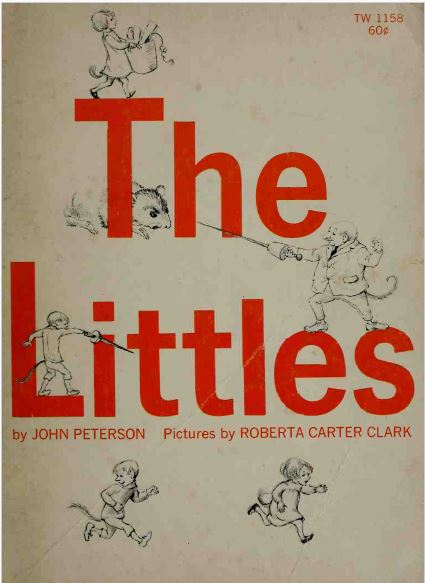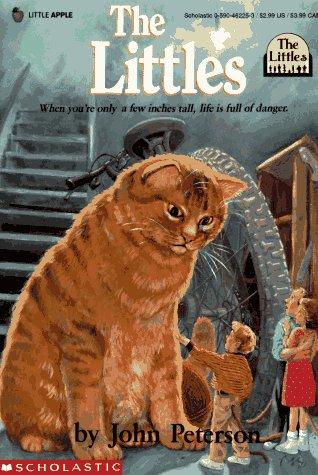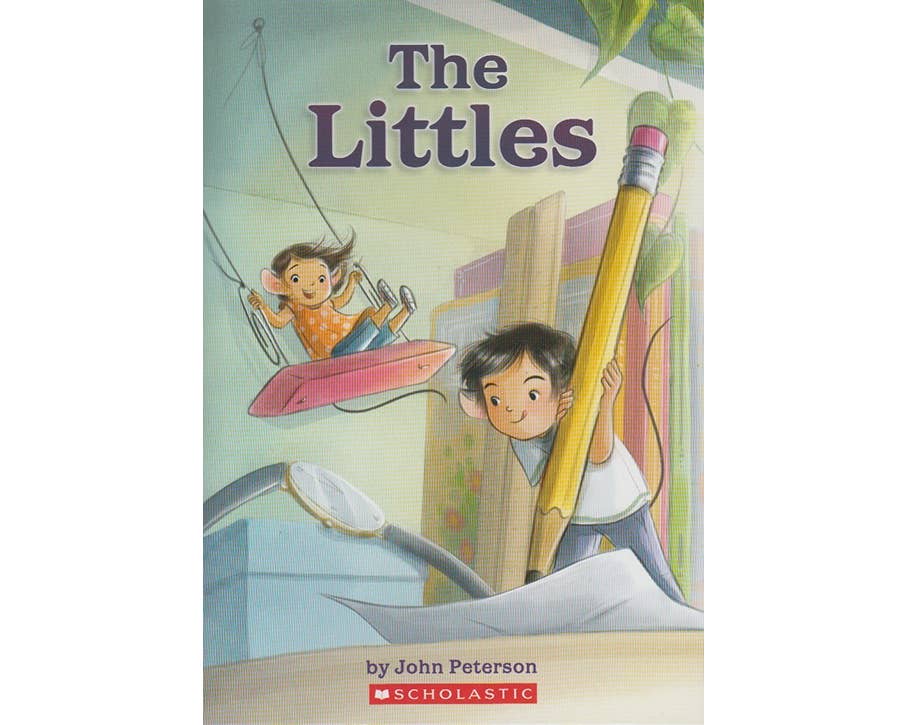At last I’ve managed to get my hands on The Littles series (1967-2002), by John Peterson (1924-2002) – well, at least most of the books in the series (still missing one, I think, but getting there!)
This is the first time I am reading them, so here is the first of a series of blog posts on these books, with some first thoughts and musings:
The first book in the series, published in 1967, is simply titled The Littles, and introduces the family of William T. Little (the dad), Mrs Little, Granny Little, Uncle Pete, Tom Little (10 years old) and Lucy Little (8 years old).
What the Littles are is a fuzzy thing, as is the case with many of the little people encountered in other children’s fantasies. In chapter 1, we are simply told that: “William T. Little and his family were tiny people” who “looked almost like people you see every day” apart from the fact that they are “much smaller” (Peterson, 1967, p. 7). We actually do get a measurement in the very first page of the first chapter, which is something that we don’t get, for example, for Mary Norton’s borrowers until the third book (The Borrowers Afloat, 1959). Like Pod, Mr Little is six inches tall, though, the narrator tells us, “he was big for a Little. The other Littles were even smaller” (ibid., p. 8).

What makes the Littles unlike “people” is perhaps the most memorable part of their physique:
In one way the Littles did not look at all like other people. They had tails. The Littles were proud of their tails. They kept them combed and brushed, and sometimes the women curled their tails when they wanted to look especially nice.
(Ibid., p. 8)
I have been noticing for a while how little people in miniature fantasies are very often compared to, or mistaken for, mice, and the Littles’ tails add to this parallel: so much so, that, later on in the story, Tom Little dresses up as a mouse, using a costume made by Granny, but uses “his own tail, of course” (ibid., p. 43). I shall return to the Littles and/vs, mice below.
The Littles are from the opening of the book set up in opposition to the Biggs. They live in a house owned by George W. Bigg, whose family are ignorant of the Littles’ presence. The Littles live in “tiny rooms in the walls of the house”, and “took everything they needed from the Biggs”, including food and small things that seemingly go “missing” (ibid., pp. 8-9). In contrast with the borrowers, whose ethics of “borrowing” (vs. what human beings would call “stealing”) are an interesting thread in the books, the Littles seem to have a secret transactional relationship with the Biggs, whom they pay back by mending and maintaining things in the house:
The Littles helped the Biggs in return for the things they took. Only the Biggs didn’t know it. For one thing, the Littles were good at fixing things. They ran back and forth inside the walls repairing the electric wires whenever they needed it.
(Ibid., pp. 9-10)
The Littles were good plumbers, too. On cold winter days they kept the outside water pipes from freezing. Often they had to stay up all night keeping the pipes warm by candle fire.
Mr. Bigg could never understand why his plumbing and electricity worked so well. “I can’t believe it,” he would say. “I have less trouble with this old house than my neighbors do with their brand-new houses.” He would shake his head. “I guess they don’t make houses the way they used to.”
This is an interesting concept. This unwitting quid pro quo points to a symbiotic relationship – specifically mutualism: a relationship between organisms of different species, in which both organisms benefit from the association. The fact that the Littles are in charge of some of the most tricky things householders often worry about (while lacking the expertise to fix them themselves), that is, electricity and plumbing, makes them particularly useful – it feels as if the text wants to provide a good excuse for the existence of the Littles, a use for them, something to distinguish them from, say, vermin – here’s the mouse associations again.
The word vermin points to both harmful and often parasitic organisms. As per above, the Littles’ existence isn’t that different from mice: they live in the walls of the house, they feed on crumbs, and they fit into all the nooks and crannies of a house, disappearing quickly when (if ever!) spotted. But mice, of course, are not just classed as vermin because they carry diseases, contaminate via their excretions, and chew through furniture, etc., but also because they often chew through electrical wires causing outages and/or fire hazards. In many ways, the Littles are anti-mice – clean, tidy, and fixing electrical problems.
Bearing this in mind, therefore, it’s not that surprising that the plot of this first book of The Littles series revolves around mice: the “inciting incident” is that the Biggs leave for a while on holidays, and the Newcombs arrive to rent the house during that time. Mr Newcomb is an artist and Mrs Newcomb a writer. They both plan to use their stay as artistic retreats, and make a conscious decision not to spend too much energy looking after the house (what that says about the story’s attitude to creatives is another story…):
The Newcombs were indeed bad housekeepers. Food was left around uncovered. Floors were not swept after meals. Garbage spilled out of the can. When the lid fell off, it wasn’t put back on.
(Ibid., p. 26)
“All those crumbs! Mark my words,” Granny said, “there WILL be mice.”
And, of course, mice do show up. The grown-ups of the Little family remember mice as old enemies. We hear of “the old days” when Uncle Pete was injured during the “Mice Invasion of ’35” (ibid., pp. 22, 28), which explains Uncle Pete’s limp, but also brings up Uncle Pete’s brother, Tim, who lost his life in that fight (or war? resonances of WWII here?). But there must have been previous “wars” with mice in the remoter past, as the Littles dig out a chest of weapons including a bow and arrow. The arrow has this inscription on it: “Made in 1825 by Chas. B. Little” (ibid., p. 29).

There are a few skirmishes with mice, but the Littles realise that the best way to get rid of them is alert the Newcombs that they exist! But the Newcombs are so oblivious that the daring plot to dress up Tom as a mouse and parade him in the kitchen is hatched up. The plan works and the Newcombs realise the error of their ways and bring in a cat. Once more, therefore, the relationship between mice and Littles is highlighted – ironically, the Littles have to become more like mice to protect themselves (and the Biggs’ house), though, the tale-tell tails are once more making this dichotomy slippery:

“It’s the first time any of the big people have ever seen any of us,” said Mrs. Little. “And the only real part of Tom they’ll see is his tail.”
(Ibid., p. 46)
Illustration for The Littles (1967), by Roberta Carter Clark
A development that the mice invasion causes is another (and very beneficial) relationship between the Littles and animals: Tom’s taming of the cat. The cat is initially seen as a new enemy (and blamed on the Newcombs and the mice), but Tom manages to control it very simply: by defying the previous generation’s fear of animals and just speaking to it:
Now Tom was standing next to the cat. He reached up and scratched her gently under the chin. The cat closed her eyes slowly and purred louder. Tom kept talking to her all the while.
(Ibid., pp. 78-9)
“It was the talking that did it,” said Mr. Little later. “The way I figure, the cat didn’t know we were people until Tom started talking to her. I guess cats like people to talk to them.”

And this is one more distinction the text makes between mice (or any other animal) and the Littles: language, popularly understood as a unique human ability (though science has challenged this for a while now). The grown-up Littles are particularly anxious to make this point:
“Now we may be little,” said Mr. Little, “but we are men.”
(Ibid., p. 70-71)
“Of course we are,” said Uncle Pete. He looked sideways at his tail. “We’re not animals.”
That “sideways” look at the tail, though, betrays some sort of doubt, perhaps.
Appendix: Tiny Materialities
Another element of miniature fantasies that interests me is the repurposing of everyday small objects for different uses when the scale of the characters is switched to the minuscule – so, a matchbox becomes a bed, an acorn cup becomes a drinking vessel, etc. I was surprised not to see much of this in the actual text of the Littles (it abounds in other miniature fantasies), but Roberta Carter Clark’s illustrations added a few examples of this phenomenon, not mentioned in the text:

In the text:
- The Littles use the electrical socket on the kitchen counter as a door to access the Biggs’ house (p. 9). They also use a hole in light switch in the hall (one of the screws is missing, apparently) as a “secret look-out place” (p. 15).
- The Littles have a tin-can elevator: “They had rigged up the tin-can elevator from an old soup can and bits of string tied together” (p. 46).
- Uncle Pete’s sword is “made from one of Mrs. Bigg’s needles” (p. 53).

In Roberta Carter Clark’s illustrations:
- Granny Little is using a wooden spool as an occasional table, on which a tin soda bottle cap holds her wool (which comes from unravelling one of the Biggs’ socks!) (p. 12)
- Uncle Pete (holding his sword) is sitting on a match box (p. 74)

Illustration for The Littles (1967), by Roberta Carter Clark 
Illustration for The Littles (1967), by Roberta Carter Clark



